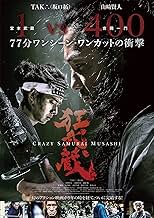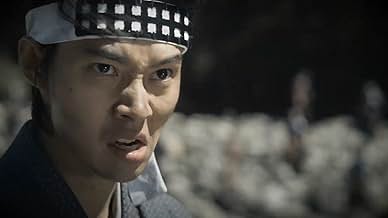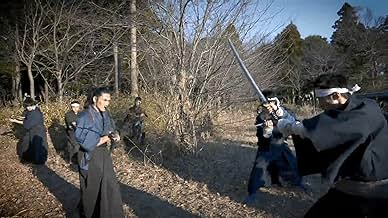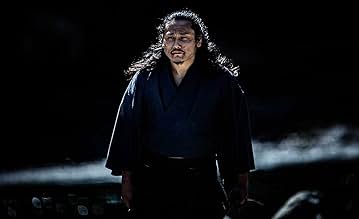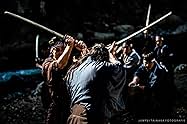AVALIAÇÃO DA IMDb
4,6/10
1,1 mil
SUA AVALIAÇÃO
Em 1604, no Japão feudal, cem membros da família Yoshioka contratam trezentos mercenários para derrotar o lendário samurai Miyamoto Musashi.Em 1604, no Japão feudal, cem membros da família Yoshioka contratam trezentos mercenários para derrotar o lendário samurai Miyamoto Musashi.Em 1604, no Japão feudal, cem membros da família Yoshioka contratam trezentos mercenários para derrotar o lendário samurai Miyamoto Musashi.
Avaliações em destaque
This is a Japanese movie? But calling it a movie is a stretch. Also apart from a exposition dump in the first 5 minutes there is about 10 lines so not that much Japanese in it. They spend over an hour with one samurai guy taking on an endless supply of stunt guys. Poor quality you could find better quality at a medieval fair show. To be fair they do slowly walk through a model Japanese village during it. It's boring what can I say how long does it take watching Japanese men struggling out of shot after being sliced then to immediately join the endless supply of grunts. It feels like a beat them up video game without any inputs and it's stuck in an endless cutscene which never ends.
I appreciate a good gimmick and an indie film that tries to go big, but this was just exhausting. The reason anyone will watch Crazy Samurai Musashi is the 70 something minute long one-shot action scene that stretches from the opening title almost to the very end. Unfortunately the very same scene is the movie's biggest downfall.
I will cut this movie a lot of slack. Obviously there wasn't a big budget and they had to squeeze every penny very hard. The talent on display here is generally fantastic, especially from main actor Tak Sakaguchi whose other roles I shall immediately seek out, the scenery is used well and very plausible. The choreography is deliberately non-flashy and rather realistic which I appreciate as a pupil of japanese swordsmanship myself. The one-shot action scene however wasn't the most compelling choice to show all of this talent off.
Every passing minute it becomes increasingly apparent how the scene was done as not only individual move lists get recycled like a standard fighting animation in a videogame, but rather entire sections of choreography. There's also a lot of obvious body armor on the stunt guys. I got most of my entertainment value from guessing the next move. Someone's looking suspiciously bulky? Belly cut! Someone's wearing a very obvious big hair wig? Gee I wonder who's getting hit in the head. Then there's the same guy who always stumbles into frame, gets tripped and cut in the back while falling. The lack of extras is a very glaring flaw. Everytime someone gets killed he literally runs out of frame to re-emerge unharmed a few moments later. It was laughably ridiculous. When enemies eventually stop running out of frame and stay on the ground you know this particular segment is about to end, our hero moves on to the next level segment where clones of the exact same guys will show up a minute later, circle around him and attack one at a time with the same pattern. Rinse and repeat for 70 minutes.
Now I understand the limitations at play here but they are rather unnecessary and self-inflicted. Had this been shot in a more conventional manner it would have been no problem to shoot and edit around them entirely and make for a more compelling, even enthralling movie. For all of its gimmicky glory the one-shot is used very amateurishly too. A lot of the action is constantly obscured by extras and the camera never moves in interesting and creative ways. The opening 30 minutes of the recent super smash hit One cut of the dead (which I assume was the inspiration) showed what fun you could have with a creative one-shot action scene. This movie felt like a chore by comparison. It just goes on and on without any tension or escalation. It's still an impressive and admirable feat, but ambition alone doesn't make a good film.
To add insult to injury the film ends in a legitimately spectacular (albeit obviously sped-up) and brutal action scene, which is shot, edited and choreographed expertly. Had the entire film been like this, with mood-setting scenes leading into gritty action, this could have become a genuine modern classic, akin to what Tsukamoto tried to achieve with his recent opus Killing. Unfortunately the director wanted to show off and ruined the amazing ingredients he had.
Every passing minute it becomes increasingly apparent how the scene was done as not only individual move lists get recycled like a standard fighting animation in a videogame, but rather entire sections of choreography. There's also a lot of obvious body armor on the stunt guys. I got most of my entertainment value from guessing the next move. Someone's looking suspiciously bulky? Belly cut! Someone's wearing a very obvious big hair wig? Gee I wonder who's getting hit in the head. Then there's the same guy who always stumbles into frame, gets tripped and cut in the back while falling. The lack of extras is a very glaring flaw. Everytime someone gets killed he literally runs out of frame to re-emerge unharmed a few moments later. It was laughably ridiculous. When enemies eventually stop running out of frame and stay on the ground you know this particular segment is about to end, our hero moves on to the next level segment where clones of the exact same guys will show up a minute later, circle around him and attack one at a time with the same pattern. Rinse and repeat for 70 minutes.
Now I understand the limitations at play here but they are rather unnecessary and self-inflicted. Had this been shot in a more conventional manner it would have been no problem to shoot and edit around them entirely and make for a more compelling, even enthralling movie. For all of its gimmicky glory the one-shot is used very amateurishly too. A lot of the action is constantly obscured by extras and the camera never moves in interesting and creative ways. The opening 30 minutes of the recent super smash hit One cut of the dead (which I assume was the inspiration) showed what fun you could have with a creative one-shot action scene. This movie felt like a chore by comparison. It just goes on and on without any tension or escalation. It's still an impressive and admirable feat, but ambition alone doesn't make a good film.
To add insult to injury the film ends in a legitimately spectacular (albeit obviously sped-up) and brutal action scene, which is shot, edited and choreographed expertly. Had the entire film been like this, with mood-setting scenes leading into gritty action, this could have become a genuine modern classic, akin to what Tsukamoto tried to achieve with his recent opus Killing. Unfortunately the director wanted to show off and ruined the amazing ingredients he had.
Personally I enjoyed the movie, but to review this or recommend the movie, I would not.
I had no idea Tak was the leading actor, and I knew it would not disappoint. Though it let me down.
The opening of the movie felt like a real movie, the camera, cinematography, colour grading, blurring etc. As soon as someone gets killed and Musashi reveals himself, then the quality all of a sudden drops.
I was shocked that the movie did the action one take with no cuts, effects or cgi. However it got repetitive, which was the movie's downfall. Same moves, same attacks, same sequences. I can understand it would be hard to find 400 actors and 400 actors who can remember the choreography and cut time, so it's fine for me if the same actors where repeating.
The movie had little story, which was a downfall, we have no idea why Musashi is killing the clans or why they want to kill him (because he killed someone Sejuiro). The effects of the movie are actually quite good, blood is not over exaggerated, but believeable.
The one shot take was cool, but very boring. I was just surprised how Tak could go on and on, which was an impressive human feat, this should go on the Guinness Book of World Record. Music were good choice, there was lack of acting.
The ending fight scene felt better than all the 70mins 1shot take.
Would I recommend this movie? No.
But I would advise you to watch if you like Samurai, Tak or one shot takes.
I had no idea Tak was the leading actor, and I knew it would not disappoint. Though it let me down.
The opening of the movie felt like a real movie, the camera, cinematography, colour grading, blurring etc. As soon as someone gets killed and Musashi reveals himself, then the quality all of a sudden drops.
I was shocked that the movie did the action one take with no cuts, effects or cgi. However it got repetitive, which was the movie's downfall. Same moves, same attacks, same sequences. I can understand it would be hard to find 400 actors and 400 actors who can remember the choreography and cut time, so it's fine for me if the same actors where repeating.
The movie had little story, which was a downfall, we have no idea why Musashi is killing the clans or why they want to kill him (because he killed someone Sejuiro). The effects of the movie are actually quite good, blood is not over exaggerated, but believeable.
The one shot take was cool, but very boring. I was just surprised how Tak could go on and on, which was an impressive human feat, this should go on the Guinness Book of World Record. Music were good choice, there was lack of acting.
The ending fight scene felt better than all the 70mins 1shot take.
Would I recommend this movie? No.
But I would advise you to watch if you like Samurai, Tak or one shot takes.
Miyamoto Musashi was a very interesting Japanese Ronin in Japan's era's of swordsmen and Samurai history. Throw in Tak Sakguchi playing Musashi and I was all set for an amazing action film. How wrong I was!
It dragged on and on with poor fight choreography and too few extras playing his enemies (it became very apparent, after 10 minutes, that the same dead guys were coming back time and time again). There were no exiting moments, no edge of your seat grippers but, there were many sword style errors; which in real life he would have been killed.
Overall i think it was poorly conceived, directed and acted with terrible choreography.
A brief HISTORY of the warrior who was the Bruce Lee of ancient Japanese swordsmen. Miyamoto Musashi, also known as Shinmen Musashi no Kami Fujiwara no Harunobu, Shinmen Takezo, Miyamoto Bennosuke or, by his Buddhist name, Niten Doraku, was a Japanese swordsman, philosopher, strategist, writer and Ronin. Musashi, as he was often simply known, became renowned through stories of his unique double-bladed swordsmanship and undefeated record in his 61 duels. He is considered a Kensei, a sword-saint of Japan. He was the founder of the Niten Ichi-ryu, or Nito Ichi-ryu, style of swordsmanship, and in his final years authored The Book of Five Rings and Dokkodo. Both documents were given to Terao Magonojo, the most important of Musashi's students, seven days before Musashi's death. The Book of Five Rings deals primarily with the character of his Niten Ichi-ryu school in a concrete sense, i.e., his own practical martial art and its generic significance; The Path of Aloneness, on the other hand, deals with the ideas that lie behind it, as well as his life's philosophy in a few short aphoristic sentences. Born:Shinmen Bennosuke, c.1584, Harima Province or Mimasaka Province, Japan. Died:June 13, 1645, Higo Province, Japan.
A brief HISTORY of the warrior who was the Bruce Lee of ancient Japanese swordsmen. Miyamoto Musashi, also known as Shinmen Musashi no Kami Fujiwara no Harunobu, Shinmen Takezo, Miyamoto Bennosuke or, by his Buddhist name, Niten Doraku, was a Japanese swordsman, philosopher, strategist, writer and Ronin. Musashi, as he was often simply known, became renowned through stories of his unique double-bladed swordsmanship and undefeated record in his 61 duels. He is considered a Kensei, a sword-saint of Japan. He was the founder of the Niten Ichi-ryu, or Nito Ichi-ryu, style of swordsmanship, and in his final years authored The Book of Five Rings and Dokkodo. Both documents were given to Terao Magonojo, the most important of Musashi's students, seven days before Musashi's death. The Book of Five Rings deals primarily with the character of his Niten Ichi-ryu school in a concrete sense, i.e., his own practical martial art and its generic significance; The Path of Aloneness, on the other hand, deals with the ideas that lie behind it, as well as his life's philosophy in a few short aphoristic sentences. Born:Shinmen Bennosuke, c.1584, Harima Province or Mimasaka Province, Japan. Died:June 13, 1645, Higo Province, Japan.
There is very little effort made in setting up how or why the fight happened and so as a story the plot (i.e. the central conflict) is lacking. Man v. man, yes, but without setting it up there's no real story here. I'm happy I bought it and watched it as encouraging innovation in chambara or jidai geki (definitely the former). As entertainment it lacks because it goes on long enough to spot some glaring issues easily ignored in shorter scenes. 1) the shortest distance between two points is a line. From the middle stance, one is always threatening the throat strike as the most efficient killing blow but he never does it. I get it for safety's sake but after so much coverage it becomes more obvious. 2) no one who charges from the high stance has any actual intent to connect the downward swing. You can tell because he's easily able to connect a slice to the midriff (should be a "men" attack probably) before the downswing ever happens. He does this without needing to step forward or do anything to throw off their timing. 3) no coordination from the attackers. The very few times they attack simultaneously, it's high so both blows can be blocked with the same block. The only way they could have won would be such simultaneous attacks but from different angles & directions. I take issue with those who say no blood gets on his blade because it's manifestly inaccurate. I agree with those who say that the few extras in the exact same outfits & hairpieces is something easily perceived after so many minutes of coverage.
Things that still impress me 1) the actor's physical stamina. Even if the "sword" is light wood, it has to be heavy enough to receive a lot of blows without visually bending or distorting. The actor holds that thing up an impressive length of time. We used to do an exercise in my Okinawan style where we would hold our arms parallel to the ground for as long as we could and it was never long. We just couldn't do it. 2) the preparation of the character for the battle in advance. He knows he'll need extra swords & water, so he set them up in advance. I'd like to circle back to the actor's stamina here because until close to the end he drinks very little of the water, preferring to rinse his mouth & his "blade." He's obviously sweating for real & doing a lot off physical activity so again, impressive. 3) the fight scene at the end.
The last bit of criticism I have wasn't mentioned yet, and that is not letting us see the last opponent defeated. After making us sit through all that attacking without even giving us the emotional satisfaction of completion felt like a deliberate waste of our time. If they were going to cut away, why not edit? Why not show the ending after spending so much time setting it up.
Things that still impress me 1) the actor's physical stamina. Even if the "sword" is light wood, it has to be heavy enough to receive a lot of blows without visually bending or distorting. The actor holds that thing up an impressive length of time. We used to do an exercise in my Okinawan style where we would hold our arms parallel to the ground for as long as we could and it was never long. We just couldn't do it. 2) the preparation of the character for the battle in advance. He knows he'll need extra swords & water, so he set them up in advance. I'd like to circle back to the actor's stamina here because until close to the end he drinks very little of the water, preferring to rinse his mouth & his "blade." He's obviously sweating for real & doing a lot off physical activity so again, impressive. 3) the fight scene at the end.
The last bit of criticism I have wasn't mentioned yet, and that is not letting us see the last opponent defeated. After making us sit through all that attacking without even giving us the emotional satisfaction of completion felt like a deliberate waste of our time. If they were going to cut away, why not edit? Why not show the ending after spending so much time setting it up.
Você sabia?
- CuriosidadesActor Tak Sakaguchi broke one finger, one rib and four of his teeth during the 77 minute battle sequence.
- Erros de gravaçãoMusahashi couldn't have known where to immediately find something to drink for each of his several breaks in a deserted village on the other clan's turf.
Principais escolhas
Faça login para avaliar e ver a lista de recomendações personalizadas
- How long is Crazy Samurai Musashi?Fornecido pela Alexa
Detalhes
- Data de lançamento
- País de origem
- Central de atendimento oficial
- Idioma
- Também conhecido como
- Crazy Samurai Musashi
- Empresas de produção
- Consulte mais créditos da empresa na IMDbPro
- Tempo de duração
- 1 h 31 min(91 min)
- Cor
- Proporção
- 1.78 : 1
Contribua para esta página
Sugerir uma alteração ou adicionar conteúdo ausente


